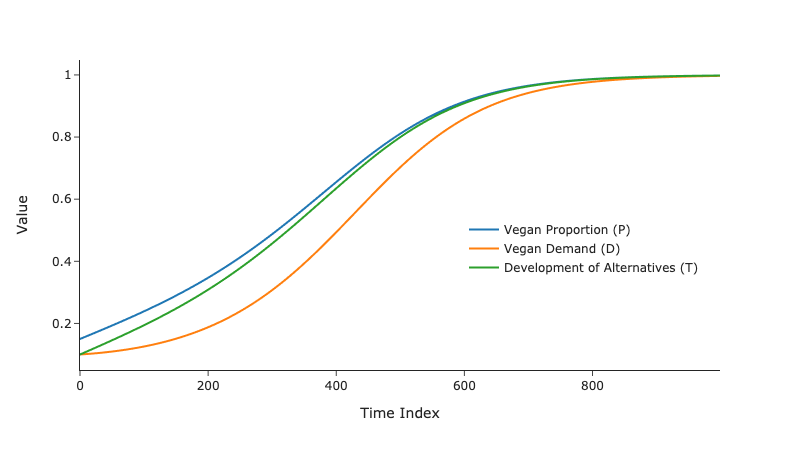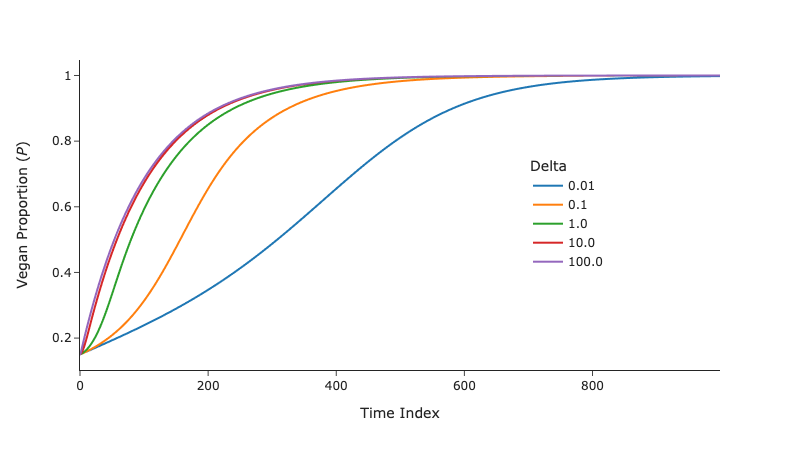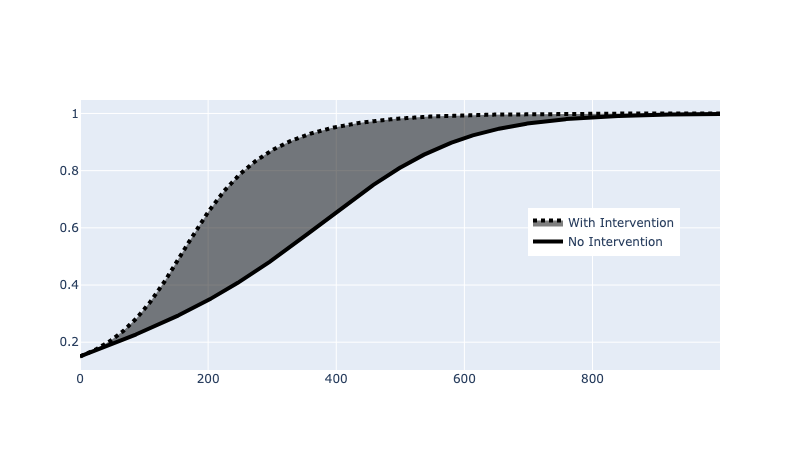Abstract
Animal agriculture is the most exigent problem of our generation. Diminishing animal agriculture would have the primary benefit of reducing colossal suffering as well as adjacent benefits such as improving biosecurity and significantly mitigating climate change. The good news is that a transition away from animal products will occur, but we can compel a tipping point sooner. An S-curve transition model suggests an underappreciated, significant benefit in advocating for steadfast veganism in consumers and institutions. Modest intervention can lead to substantial good, vastly more than the superficial consequences would indicate (thousands of cows versus just a fraction of one). When considering the tipping point case, vegan advocacy should be a foremost thrust for Effective Altruism because it can shift up the timeline for the vegan transition.
Introduction
Animal agriculture is humanity’s most destructive technology. There are substantial, significant reasons for diminishing and replacing animal products:
- The welfare argument - A significant fraction of 70 billion animals slaughtered per year experience some of the worst unnecessary suffering inflicted in human history. Even if the suffering is less than that of a human, it’s significant. Suppose animals suffered 1/1000th as much as humans, that’s 70 million humans–more than the population of France. Wouldn’t that be one of the most important crises today? Furthermore, the vast slaughter itself can be viewed as objectionable, even if livestock does not suffer while being raised.
- The biosecurity argument - More than 70% of antibiotics worldwide are used for animal agriculture, potentiating opportunities for super-resistant microbes. Additionally, naturally-occurring pandemics often have zoonotic origins because animals are biologically similar to humans. Animal agriculture often concentrates animals and increases exposure to wild-life animals. Social distancing rules apply to animals as well, so a more transmissible pathogen is increasingly likelier with current practices.
- The technological argument - Animals are irredeemably inefficient bioreactors to produce large quantities of material, i.e. food, clothing, and biologics namely. Microbial fermentation and plant-based technology can surpass the physical limits of animals and exceed any quality we seek including taste, affordability, and nutrition. I’ve written a layperson-oriented non-fiction book After Meat to explain this argument in detail.
- The resources argument - Given that animal technology is so inefficient but widely used, significant resources feed animal agriculture. So it’s not just greenhouse gas emissions, it’s also land usage. Replacing animal agriculture with >100x faster microbial fermentation would yield double benefit: reducing emissions and freeing up gobs of land that could be repurposed for sequestration or to reduce wild-life suffering. Calculations suggest that the opportunity cost of animal agriculture for carbon dioxide is one of the most tractable, sizable opportunities for addressing climate change.
- The food security argument - A car-sized microbial fermenter could produce the equivalent of 10,000 cows worth of meat in a year. With alternatives, we’d have an easier time allaying world hunger and hedging compared to a fraught animal agriculture supply chain where a disease or slaughterhouse shutdown can lead to a supply-side shock.
I hope the magnitude of the problem is clear; humanity should be pouring billions–if not trillions–of dollars into replacing animal agriculture. Even though that hasn’t occurred, we will eventually transition away from animal products because technology will be the overriding force. We’re starting to see this manifest; for example, plant-based milk has captured a significant market share. And the Impossible and Beyond Burger are lauded by omnivores and continually decreasing in price. More successors are on the horizon too.
Simultaneously, we see increasing social sensibilities about veganism and abstaining from animal products similarly to how humanity evolved its thinking about minority races and the rights of women. Brits are seemingly past “peak meat”; consumption of meat per person is decreasing. And Israel is estimated to be 5% vegan with many citing animal welfare as a concern.
Ultimately, I see an S-curve transition occurring. Where a mixture of social and technological developments will lead to a rapid, pronounced increase of veganism to the point of normalization. We’ve seen socially-driven S-curve transitions; for example, 88% of Americans were against same-sex marriage in 1988, but now only 31% are. Likewise, we’ve seen technologically driven S-curve transitions; for example, iPhone-style touchscreen smartphones have displaced push-button predecessors and landlines. Similarly, tomatoes, which were discovered in South America, were regarded warily in Europe, but soon dominated cuisines around the world starting in the 17th century.
Vegan advocacy can spur the transition sooner. I submit that one of the most important efforts that Effective Altruists could be doing is triggering the veganism S-curve, i.e. reaching the tipping point earlier. It’s a unique S-curve in that it’ll be both technologically and socially driven. In this post, I delve into the social component and the impact that individuals and institutions could have by steering toward more uncompromisingly vegan diets.
The Model
I see the transition reaching completion when all mainstream restaurants and institutions serve 100% vegan meals due to significant demand from consumers. I expect stragglers such as Chick-Fil-A, who doubled down on their stance against same-sex marriage. But for the most part, I expect all progressive-leaning institutions to switch over. Eventually, the Ivy League universities, the Apples/Googles, and leading newspapers will cease serving animal products in their dining halls/events.
We can quantify the transition as the proportion of vegan meals served at restaurants, dining halls, and catered events. This proportion will naturally increase as more people demand vegan offerings. As provisions increase and as they get better, more people will gravitate toward a vegan diet. Hence, we can conceive of an S-curve phenomenon occurring.
In parallel, alternative food companies and academic efforts can advance the knowledge and technology of vegan options. In After Meat, I argue that the technological ceiling of alternative foods is not mere parity with animal products; it’s surpassing them. Therefore, we want to account for this effect as well as we anticipate the transition. We’ll get to a point where an individual’s pure self-interest will favor vegan options.
The most formal way to account for all of the interactions is with a mathematical model. If you haven’t had calculus, feel free to skip further down to the graphs–understanding the math is not necessary for my points. Note: This model is less about predicting real world effects from real data and, instead, is meant as an explanatory tool. If you believe that the variables interact in the ways that I pose, then it’s helpful.
- I quantify the proportion of vegan offerings as P, the main signifier of the transition.
- The proportion of meals that consumers demand to be vegan, D, affects P.
- The technological development T of alternatives factors in; as alternatives get better and better, there will be more demand for them. We can imagine this as a probability that an alternative is better than a conventional animal product.
Both vegan demand and technological developments have ceilings, so they also follow an S-curve trajectory. We can formulate differential equations to model these interactions:
I’ve included factors ρ, δ, and 𝜏 to (1) convert units and (2) to account for some phenomena:
- ρ might account for how responsive institutions and restaurants are to vegan demand.
- δ might say something about how available the alternatives are or how good vegan advocacy is. It might also account for the unfortunate government subsidies for animal agriculture.
- 𝜏 could account for how much government funding goes into researching alternatives.
For now, I’m not going to worry too much about the exact values of these and will just set everything to 0.01 [1/time units].
Dynamic differential equations require initial conditions:
- P0 is the initial availability of vegan options, and generally, it’s above demand because non-vegans can eat vegan; for example, I noticed that pizzas at events in grad school would often be 50% vegetarian even though only maybe 10% of the attendees were.
- D0 is the starting amount of demand for vegan options, clearly related to the proportion of the population sticking to veganism or flexitarianism at certain times.
- T0 is how good alternatives are compared to their ceiling–I have no idea about this, and it’s impossible to say.
So, we’ll arbitrarily set the values as follows: P0 = 0.15, D0 = 0.1, T0 = 0.1
We can now plot the model:

As expected, we see an S trajectory with all three curves, and as predicted, P will always lead D. Next, we want to understand what things we can affect in order to tip sooner. How about if we invest more into the development of alternative foods. That’s tantamount to increasing 𝜏 (tau) or T0:


We reach diminishing returns very quickly with technological investment. This happens because dP/dt is not directly proportional to T, as opposed to D. So, if we account for better vegan advocacy, i.e. increasing δ (delta) or D0:


We see that increasing demand is an impactful way to catalyze the transition. Technology (T) doesn’t abrogate the benefit of advocacy (D).
The Integrative Benefit
This tipping point model helps us understand an underappreciated benefit of vegan advocacy. Getting to a vegan world sooner ushers in many benefits that I highlighted in the Introduction. So, we can understand the net benefit of advocacy as the area difference from shifting the curve to the left:

When we think about the consequences of a vegan meal, we often think about that meal in a vacuum. For example, by avoiding the beef burger for one meal, I’ve spared ~1/1600 cows. From that vantage, it seems discouraging and pointless. As Will MacAskill highlights in Doing Good Better, donations are way more effective toward direct animal welfare improvements.
But when we understand the vegan meal choice through the lens of S-curve transitions, the impact is huge. Imagine one interaction moves the S-curve earlier by an hour. That means ~8 million animals are spared. (Calculated 70 billion animals divided by 365 days * 24 hours).
Final Thoughts and Next Steps
I hope I’ve convinced you that the S-curve shifting is a powerful way to see the impact of vegan advocacy. I also hope that there’s a newfound appreciation for vegan advocacy.
- The biggest tipping point can occur through institutions. Jacy Reese Anthis’ great book The End of Animal Farming emphasizes the tractability of advocating toward institutions. Imagine the cascading effect if Harvard University or The New York Times had a full vegan mandate, e.g. vegan food for all events, dining, and travel expenses. Those would be big jumps in some of the values above, e.g. D. Institutions are sensitive to social winds as we saw during the MeToo and George Floyd movements. For example, the Golden Globes was effectively annihilated for not acting fast enough on inclusivity.
- Anti-speciesism is the bigger, better value. I acknowledge there is more to animal advocacy than merely ending animal agriculture. We also want to instill anti-speciesist values in a greater population and help wild-life animals too. We can imagine that we’re also trying to get to another S-curve transition of expanding our moral circle.
- It may be more helpful to separate industries and S-curves. Nearly all of the world’s insulin today comes from microbial fermentation as opposed to pig pancreases before the 1950s. Similarly, we may see different S-curves for different industries. Foie gras or veal may go sooner. And cheese may go later.
- Tractability and resources required matter. DiDi Wei and Brian Tomasik highlight a good point in that emphasizing technological improvement may still be the way to go if it’s a more tractable and less-resource intensive path. Even if advocacy is more potent, we have to factor in the costs to implement it. And donations certainly may be more effective than meal choices when it comes to advocacy.
- Research indicates some decisive thresholds. 10% to 25% has been floated as a critical amount where massive adoption begins to occur and a movement ceases to be marginal.
- Vegan inflexibility can be practical. I know that being inflexible is often chided as impractical, if not self-defeating, in EA circles. A tipping point model suggests that’s not necessarily true. If I call a restaurant and ask them what their vegan options are, and they say, “Well, we can take the cheese out of the stuffed mushrooms.” Then I might say, “Okay, that’s pretty meager. I’m going to another place. Thanks.” The restaurant gets the cue to develop more options, which then makes it easier for people to go vegan, and thereby speeds the transition.
- But there is room for flexitarianism. What matters is hardline vegan demand on planned occasions. A flexitarian may have a vegan Wednesday, in which case, the same awkward restaurant interaction may play out then. I see D as the proportion of occasions where the vegan demand occurs. Whether it’s a binary or tailing distribution among people is immaterial. Newly elected mayor Eric Adams started Vegan Fridays at New York City public schools. I anticipate this having a positive, significant effect on the S-curve transition.
- An ode to the OG vegan activists. The model suggests that net benefit advocacy diminishes as the demand D grows. This means that the pioneers have had the largest impact because they’ve shifted the curve to the left the most. I salute you, vegan activists, who laid the groundwork in the 60s and 70s when veganism was completely alienating. Today, vegans, such as myself, have an easier time walking into nearly any Bay Area restaurant and having options. On a similar note, if you’re in an area where veganism is still foreign, then you can do so much good by being a force for the S-curve. Really, the harder it is, then the more good you’re doing! Take solace.
- Let’s work together! I hope this post was helpful and informative. My biggest outside-work activity is figuring out how to spur the transition past animal products. If you’re working on something similar and I could help, please reach out. I’m a data scientist with a doctorate (expertise in systems/quantitative biology), and I work in the alternative food industry. I’d also be delighted to work with someone to refine the model or motivate institutions to pledge themselves against animal products.
Thanks for reading!
Sincerely,
Karthik
Acknowledgments
I thank Jeffray Behr, Tobias Baumann, DiDi Wei, Brian Tomasik, Elad Noor, and Oscar Horta for providing comments and feedback on a draft version of this post. They've helped improve it significantly!

Hey Karthik. I'm interested in the same subject: spreading the plant based diet. I wrote this article and also linked to yours. Curious about your opinion. Thanks
Hey Johannes, I'll reply with some thoughts over the next few days. Thanks!
I appreciated this. Thank you.
Thanks for writing this!
You changed my views considerably. I now see how being a vegan will force businesses to adapt faster, even driving technological change. This effect is much stronger than just the meat one has avoided to eat.
Another insight I hadn't considered is that a (big) company or instution going 100% plantbased would change the norm. So advocating for this seems very effective to me.
Thank you! I appreciate the kind words :)